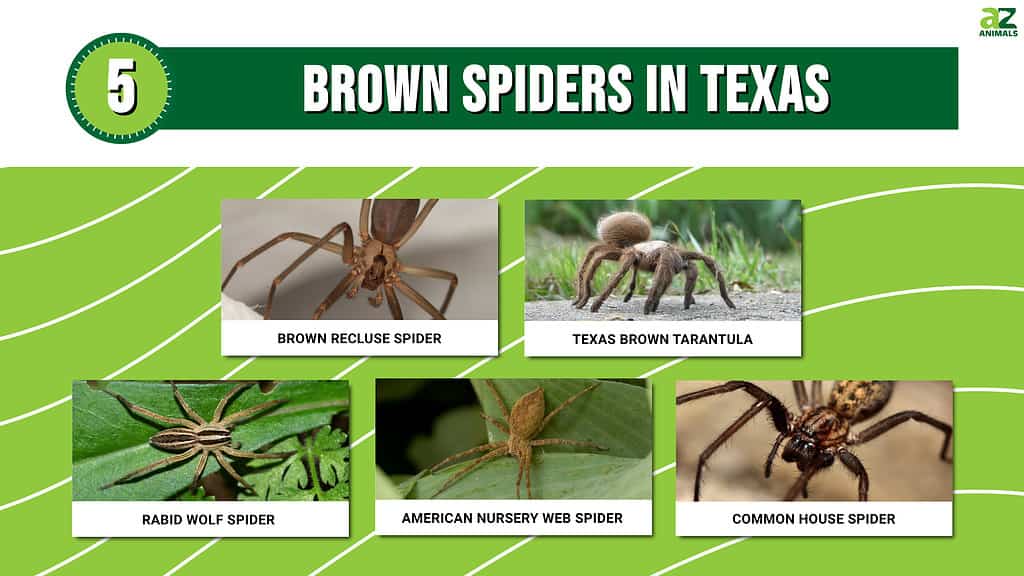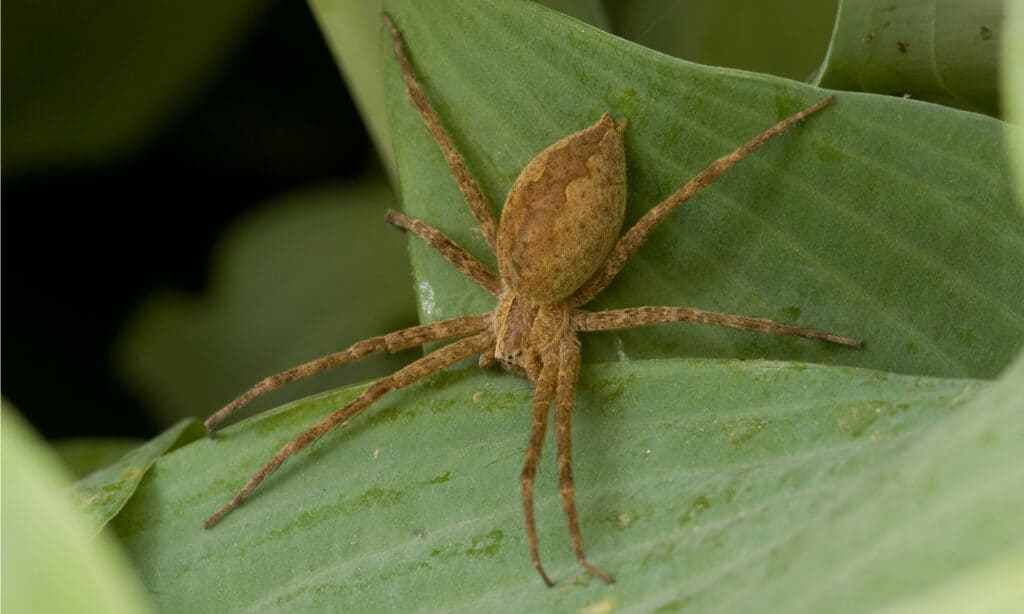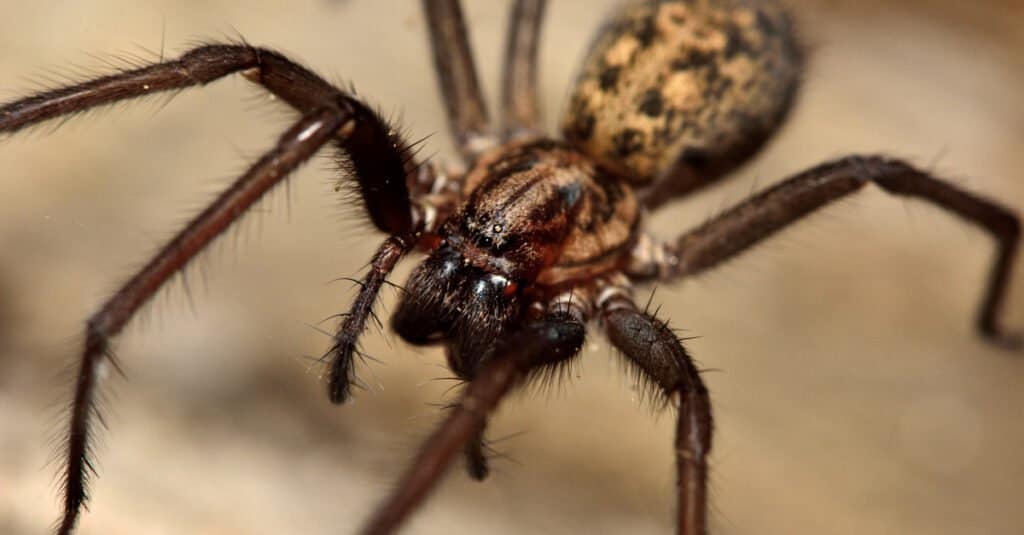Spiders are the largest order of arachnids and they are found worldwide on every continent, except Antarctica. There are over 3,400 species of spiders in North America and Texas alone is home to over 900 species, with the largest population occurring in Austin, Texas. Unique among arthropods, their bodies consist of two segments; the cephalothorax and the abdomen, connected by a small cylindrical section called the pedicel. While most spiders are generally harmless, the venom of a few species is dangerous to humans, with the brown recluse and black widow spiders being the most dangerous of them all.

Though there are numerous brown spiders in Texas, this article focuses on the most common ones people encounter in and around their Texas homes. So, read on to discover these five notable brown spiders and how you can differentiate each of them.
5 Brown Spiders in Texas
Brown Recluse Spider

The brown recluse spider measures between 0.24 and 0.79 inches.
©Nick626/Shutterstock.com
The most common brown spider in Texas, the brown recluse spider usually measures between 0.24 and 0.79 inches but may grow larger. While typically brown, these spiders usually have markings on the dorsal side of their cephalothorax, with a black line coming from it that looks like a violin. Also, recluse spiders have six eyes arranged in pairs, instead of eight eyes like most spiders. They frequently build their webs in cardboards, sheds, woodpiles, garages, closets, cellars, and other places that are dry and generally undisturbed. The brown recluse spider is one of the two medically significant spider species in Texas, the other being the black widow spider. It has a highly toxic necrotic venom and its bite requires medical attention. Though It is rarely aggressive, bites from the species are uncommon. Adult brown recluse spiders often live about one to two years.
Texas Brown Tarantula

The largest spider species in Texas is the Texas brown tarantula.
©texas brown tarantula/Shutterstock.com
The Texas brown tarantula is one of the most common species of tarantula living in Texas today. They are dark brown, hairy spiders that can grow to leg spans more than 4 inches (10 cm), and weigh more than 3 oz as adults – making them the largest spider species in Texas! Their bodies are dark brown, though shades may vary between individual tarantulas. This species is commonly found in grasslands, burrowed underground, or under logs, and stones, which they use as their homes and feeding grounds. Females have been known to live up to 40 years while males rarely live over a year after they have matured.
The Texas brown tarantula is a rather docile and non-aggressive species but when disturbed, maneuvers itself to a stance on its hind legs and raises its front legs in a threatening manner. They also have small, coarse hairs on their abdomens that they kick in the direction of whatever they may feel threatens them. Bites are generally not serious harm to humans except in the case of an allergic reaction. Due to the large size of their fangs, the puncture wound from a bite can also be painful and lead to secondary infection if not properly treated.
Rabid Wolf Spider

Texas Wolf spiders, or Rabid Wolf spiders are harmless to humans but larger specimens can give a painful bite.
©Brett Hondow/Shutterstock.com
Distributed widely in the United States, rabid wolf spiders have eight eyes: four above, and four below. Females are larger than males, and have a body length of about an inch, while the males’ body length comes to half of that. These brown spiders have two dark stripes on the cephalothorax, while the abdomen has one stripe of the same color. They are commonly found in cotton fields and wooded areas. They also live in holes and garbage of various kinds. Sometimes they might be found around ponds or in deep burrows that are covered by debris. Rabid wolf spiders don’t build webs to catch prey, instead, they weave the silk to wrap their prey in, or to protect their young. Wolf spiders may bite if provoked, but their bite is not dangerous to humans.
American Nursery Web Spider

Male American nursery web spiders will tie females’ legs during mating to avoid being eaten afterward.
©SDeming/Shutterstock.com
Though they are often mistaken for wolf spiders due to their physical resemblance, American nursery web spiders are distinguished by their unique eye arrangement of two rows: four eyes in the front forming a straight line, and four eyes in the back forming a U-shape. These brown spiders are wandering hunters, so they are usually found on vegetation or at water margins throughout North America. They are also seen in the woods and meadows but are most populated in the transitional areas between woods and fields. One of the most interesting things about nursery web spiders is that the females are well known for sexual cannibalism; they eat the males during mating. To avoid being eaten, the male wraps the legs of the females in silk before and during copulation. Although the venom of the nursery web spider is enough to kill its prey, which is usually small insects, it is insufficient for any lethal damage to humans.
Common House Spider

Common house rpiders reside in corners and typically choose spots where there’s good airflow.
©IanRedding/Shutterstock.com
Common house spiders live in and near human dwellings. They are variable in color from brown to nearly black, frequently with patterns of different shades on their body. Females are generally between 0.20 and 0.24 inches long (5 to 6 mm), and males are generally between 0.15 and 0.19 inches long (3.8 to 4.7 mm). Common house spiders usually feed on small insects and household pests such as mosquitoes, wasps, flies, and ants. Three spider species usually prey upon them – pirate spiders, as well as two jumping spiders– Metacyrba undata and Phidippus variegatus. As these brown spiders live in constant proximity to humans, they are not usually aggressive and will even let a human hand touch their web. Common house spiders will bite humans only in self-defense when grabbed and squeezed. Though they have neurotoxic venom, their bites are less severe and are not known to be dangerous to humans.
Summary Of The 5 Brown Spiders In Texas
| Rank | Brown Spider |
|---|---|
| 1 | Brown Recluse |
| 2 | Texas Brown Tarantula |
| 3 | Rabid Wold Spider |
| 4 | American Nursery Web Spider |
| 5 | Common House Spider |
The photo featured at the top of this post is © texas brown tarantula/Shutterstock.com
Thank you for reading! Have some feedback for us? Contact the AZ Animals editorial team.






